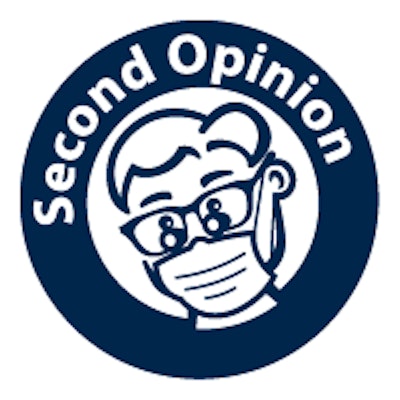

What are people getting for prevention?
 Jeff Album of Delta Dental.
Jeff Album of Delta Dental.The answer is contained in what I've outlined in the last column. A standalone pediatric dental plan always carries either an 85% or 70% actuarial value. This means the deductible is always low, the high plan almost always pays 100% for all diagnostic and preventive (D&P), and the low actuarial value plan may require a $20 to $50 deductible before any services are covered.
With embedded dental plans (wherein a health plan includes pediatric dental coverage in its health policy), it's harder to know what the consumer receives, and it depends entirely on the health plan that offers the policy. There could be 100% coverage for D&P or 0% until a $2,000 or higher deductible is met. The out-of-pocket maximum for these plans runs $6,600 per individual annually -- which is a combined medical/dental out-of-pocket maximum. So unless a child has high medical expenses, the 100% coverage will never be reached. By contrast, the out-of-pocket maximum for children in a standalone dental plan can never exceed $350 for an individual or $700 for two or more children.
Is it mandated that customers receive a minimum of two exams and two fluoride treatments per year at no additional expense past the premium for all plans sold?
No, not exactly. But since exams and fluoride are in all the state-selected benchmark plans, they must be in the policy. They are generally subject to the same limitations and exclusions of a commercial policy, which almost always allow for two exams, cleanings, and fluoride treatments a year. And remember that the actuarial value requirements on standalone dental plans pretty much guarantee that these procedures will be covered at no additional expense for the high actuarial value plans and will be subject to a small deductible in the low actuarial value plans.
With embedded dental, it all depends how the medical plan chooses to embed its dental and whether D&P is carved out from the combined medical/dental deductible.
Why are there 300 variations of preventive dental plans for sale?
The federal actuarial value requirements inherently allow for, and even encourage, these variations. There are several ways to design a benefit program to get to 70% or 85%. Reduce coverage for D&P and increase it for basic and major restorative, or the reverse. If an actuarial value comes in too high, add a waiting period to certain procedures. These are just examples. The point is that every medical and dental plan is subject to this variability within the actuarial value requirements.
Still, with a strict actuarial value limit set on standalone dental plans, all these plans must deliver the same relative value to the consumer, because the actuarial value guarantees a fixed ratio of coverage to patient cost-sharing. And it's the design variation that allows consumers to buy a program most suited to their particular needs. Bear in mind that the low actuarial value plans are more affordable. So while they may not cover all costs associated with D&P, they do bring more families (not just children) to the dental office. So even what the plan doesn't cover, these are paying customers in the chair.
With embedded dental, there is no actuarial value -based constant or constraint. The actual value of these benefits can range from negligible to low to high, depending on how the health plan chooses to offer them.
Why do some plans have to reach a deductible threshold before dental benefits kick in, including prevention?
Again, the federal rules surrounding actuarial value and the differences in those rules for standalone dental versus embedded dental are the answer to this question.
Are those really dental insurance plans when there is such a high requirement for first dollar coverage?
For an embedded dental plan with a $2,000 or higher combined medical/dental deductible and no carve-out for D&P, the question is a fair one. Such plans seem illusory; they are of little value to most children, and, therefore, they are much cheaper when you compare them in the exchange with the cost of buying separate standalone medical and dental benefits.
Price variability is one of the things the ACA's architects wanted on the exchanges. The concern here is whether consumers are really aware of what they are buying when they make their exchange selections. One of our goals in working with federal agencies right now is to try and get better transparency into these new marketplaces.
Why is there a bundled plan and an embedded plan?
Bundled dental plans operate outside of exchanges, not inside, and under standalone dental rules. This means they feature the same low-to-no deductible and lower out-of-pocket maximum than the embedded dental plans. The "bundle" delivers that same low-deductible, low maximum out-of-pocket benefit with guaranteed actuarial value that all standalone dental policies have, and the bundle can be conveniently purchased at the same time as the medical plan, with a combined single bill.
Finally, Dr. Hirsch noted that some of the most affordable medical plans have medical deductibles of $5,000. He asked if preventive dental services were part of the included medical preventive services, such as immunizations that are covered at 100%? He also noted that no dental services are included on this list of pediatric medical services covered at 100%.
This is answered above. It just depends, but generally, if the health plan is trying to be among the "most affordable" health plans offered in an exchange, then dental D&P will not be carved out from that high deductible. There is very little, if any, "coverage" in these kinds of embedded dental plans, which harks back to my comment that such plans seem illusory.
In conclusion, it should be apparent that there is a lot going on with regard to the types of dental policies being sold in public exchanges around the country. Most of the variation is because of the laws that created the exchanges and exist outside the exchange in the various state insurance codes. That's why it's important to ask a lot of questions regarding the coverage that each dental carrier is offering.
When a recruiter comes along asking you to join their network, a few simple questions about the policies being sold on exchanges can address the concerns Dr. Hirsch mentions in his article. Is D&P covered, or is a deductible applied? If the latter, how much? Are there any waiting periods? How popular is your exchange-based policy? Will it really deliver patients to my office?
Last but not least, is the fee schedule acceptable, and does the company have a reputation for treating dentists well in terms of attention and service? Not small matters at all.
Jeff Album is vice president of public and government affairs for Delta Dental of California, Delta Dental of New York, Delta Dental of Pennsylvania, and their affiliates. They are all part of a San Francisco-based dental insurance holding company system that is represented in 40 public state health exchanges.
The comments and observations expressed herein do not necessarily reflect the opinions of DrBicuspid.com, nor should they be construed as an endorsement or admonishment of any particular idea, vendor, or organization.



















